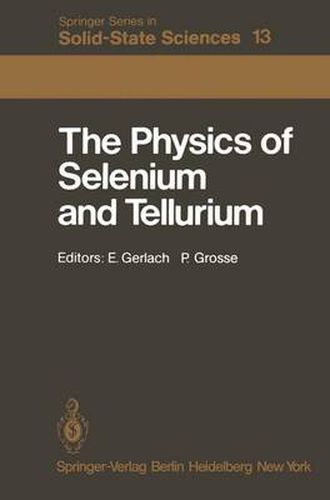Readings Newsletter
Become a Readings Member to make your shopping experience even easier.
Sign in or sign up for free!
You’re not far away from qualifying for FREE standard shipping within Australia
You’ve qualified for FREE standard shipping within Australia
The cart is loading…






This title is printed to order. This book may have been self-published. If so, we cannot guarantee the quality of the content. In the main most books will have gone through the editing process however some may not. We therefore suggest that you be aware of this before ordering this book. If in doubt check either the author or publisher’s details as we are unable to accept any returns unless they are faulty. Please contact us if you have any questions.
Conferences on the Physics of Selenium and Tellurium were held in 1964 in London, 1967 in Montreal, and eight years ago, 1971, in Pont-a-Mousson. The last conference was noteworthy because of two facts: For crystalline Te and Se a high level of results was achieved and, further, it was possible to outline the focal points for continuing research work. These points were mainly to explore. the electronic structure of trigonal Se and Te and of the hypothetic~l cubic limit of these materials. To im plement such study, progress in band structure calculations was necessary. In addition, a consistent analytical description of the bands near the va lence band conduction band gap was required with the aim to understand the semiconducting properties, mainly magnetotransport and magnetooptical ef fects of band electrons and of impurities. Further questions concerned the influence of defects, such as dislocations, on transport properties and, finally, a concluding description of lattice dynamics of trigonal Se and Te, based on theoretical and experimental work, such as neutron diffraction and optical measurements. Besides the listing of this future research program it became obvious that more detailed work on the amorphous state of solids and liquids was necessary in order to improve our knowledge about their crystalline proper ties, growing conditions. and all problems of chemical bonds.
$9.00 standard shipping within Australia
FREE standard shipping within Australia for orders over $100.00
Express & International shipping calculated at checkout
This title is printed to order. This book may have been self-published. If so, we cannot guarantee the quality of the content. In the main most books will have gone through the editing process however some may not. We therefore suggest that you be aware of this before ordering this book. If in doubt check either the author or publisher’s details as we are unable to accept any returns unless they are faulty. Please contact us if you have any questions.
Conferences on the Physics of Selenium and Tellurium were held in 1964 in London, 1967 in Montreal, and eight years ago, 1971, in Pont-a-Mousson. The last conference was noteworthy because of two facts: For crystalline Te and Se a high level of results was achieved and, further, it was possible to outline the focal points for continuing research work. These points were mainly to explore. the electronic structure of trigonal Se and Te and of the hypothetic~l cubic limit of these materials. To im plement such study, progress in band structure calculations was necessary. In addition, a consistent analytical description of the bands near the va lence band conduction band gap was required with the aim to understand the semiconducting properties, mainly magnetotransport and magnetooptical ef fects of band electrons and of impurities. Further questions concerned the influence of defects, such as dislocations, on transport properties and, finally, a concluding description of lattice dynamics of trigonal Se and Te, based on theoretical and experimental work, such as neutron diffraction and optical measurements. Besides the listing of this future research program it became obvious that more detailed work on the amorphous state of solids and liquids was necessary in order to improve our knowledge about their crystalline proper ties, growing conditions. and all problems of chemical bonds.